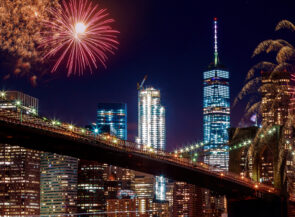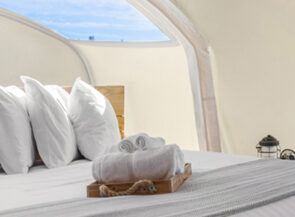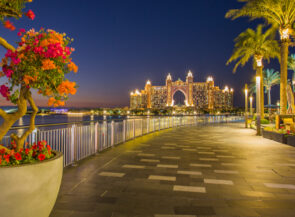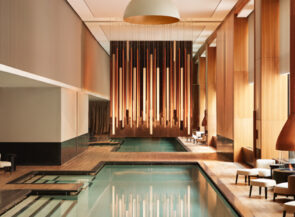In the six decades since Dubai struck oil, this former fishing and pearl-diving settlement has emerged as a futuristic boomtown, home to the world’s tallest skyscraper, more than 150 five-star hotels, and entire archipelagos of whimsically shaped artificial islands. That bigger, faster, higher, glitzier mentality defines the culture here, but the city is also going deeper—engaging more critically with its Arab identity while embracing the immigrants who account for about nine in 10 Dubai residents. These days, adventurous galleries push the boundaries of what you might expect to find in the Gulf region, while young chefs showcase nostalgic Middle Eastern flavors in fine-dining spaces that had previously been reserved for foreign fare. In a city that recently welcomed the groundbreaking Museum of the Future, the people continue to shape what the future will look like, both here and abroad.
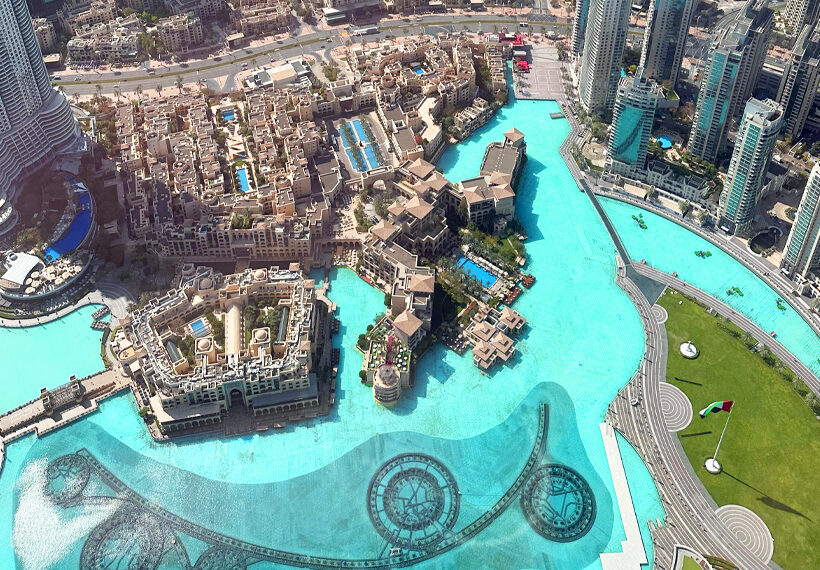
Day 1
Political art, dancing flamingos, and ‘third-culture cooking’
I’m slightly ashamed to admit that I start my first morning in this modesty-minded city by letting out an expletive before my head even rises from the pillow. I arrived after dark last night and checked into the Jumeirah Beach Hotel, a wave-shaped tower on the sizzling sands of the Persian Gulf. I awake as the sun is rising, and the first thing I see is the sail-shaped Burj Al Arab (a seven-star sister property) bathed in a glow that’s as soft pink as the inside of a bunny’s ear; it’s so iconic and gorgeous that I can’t help but shout.
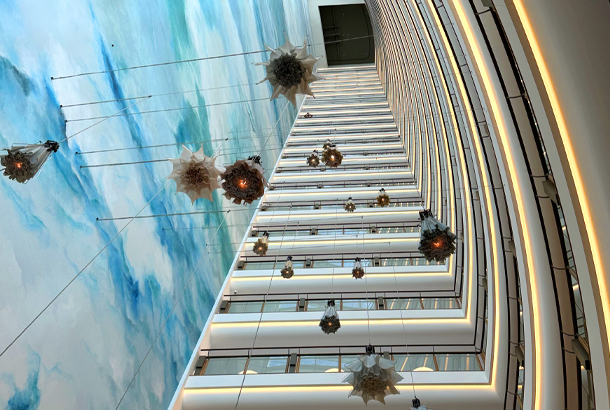
The homegrown Jumeirah chain dominates this stretch of waterfront, a few miles south of downtown, with a lineup of hotels that run the gamut from beachy and family-friendly to more Arab-inspired and glamorous. It’s a hive of activity, with kids splashing around in pools, jet skis bobbing along the horizon, and socialites tottering along sandy pathways in out-of-place heels. On my way out for the day, I stop in my hotel’s atrium to take a quick video of an undulating kinetic sculpture that calls to mind pulsing jellyfish. Nearby, gold-tinged portraits of the royal family that look a bit like Russian Orthodox icons hang by the doorway—a reminder of the once and future sheikhs who made all this glitz possible.
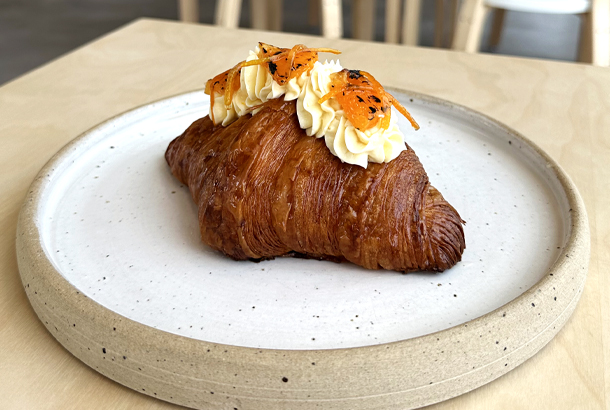
For breakfast, I head to Teible, a sunny café at the Jameel Arts Centre, which gives off the impression of a pile of giant sugar cubes on the shore of Dubai Creek. I order a blood orange croissant and a sophisticated “bodega muffin” (stuffed with scrambled eggs, braised beef rump, Manchego cheese, and Malaysian chili paste) before strolling through the free museum. I’m taken by the quiet radicalism of the works here, including Pakistani artist Risham Syed’s map quilts, which drip with cultural references and commentary on post-imperial geopolitics.
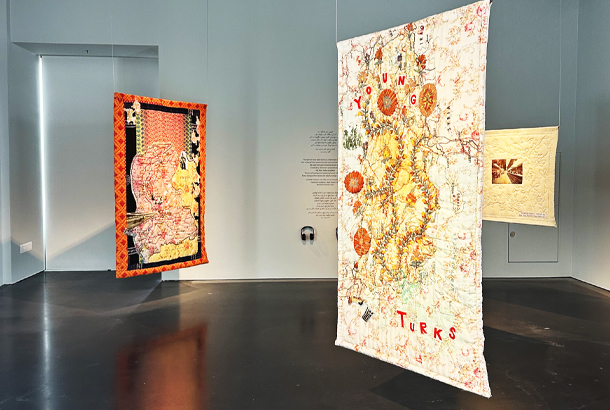
I love to incorporate bird-watching into any travel itinerary, no matter how bustling the metropolis, and I’ve found a perfect spot for serene contemplation: the Ras Al Khor Wildlife Sanctuary. At this wetland reserve, which sits just off the highway in the middle of the city, I gaze at a flock of shockingly pink flamingos, who stomp their feet in a tap-dancing display to rustle up some grub. Their appearance—all vertical lines and ostentatious feathers—feels like a natural analogue to the skyline behind them, a collection of postmodern marvels that similarly skirt the line between elegant and over-the-top.
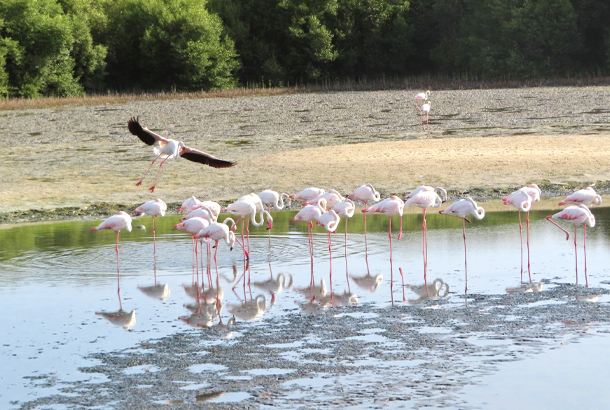
Lunch today is at Orfali Bros, which was recently included on the World’s 50 Best Restaurants list. The unassuming bistro in the Wasl 51 development is run by three brothers from Aleppo, and I’m greeted by one of them, Mohamad Orfali, a boisterous former Syrian TV host in thick-framed black spectacles. “Dubai is like a paradise,” he says. “You can find all the world here.” In part because there are seven nationalities represented in his kitchen, he calls his food “Orfali cuisine—a cuisine that has never existed before.”
Early dishes include a Spanish-inspired vegetarian “bacalao,” made from celeriac instead of salt cod, and an “umami eclair,” with a porcini emulsion, mushroom Marmite, cacao nibs, fermented quince paste, and prosciutto. “You feel like you’re eating foie gras,” Orfali says, “but there’s none in there.” There is also a silky eggplant topped with walnuts and nasturtiums, a shiso-wrapped bulgur salad with chili paste, and a Wagyu gyoza that mimics Levantine fermented sausage.
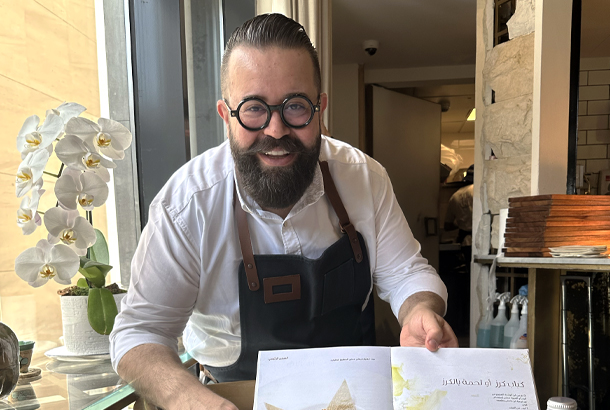
“Come with me to Aleppo now,” Orfali says as he serves me a sour cherry kebab, the signature dish from his war-torn city. “We like people to close their eyes and pray for Aleppo with the first bite.” His hometown is the oldest inhabited city in the world, and “the food has centuries of flavors,” he observes, “but our food needs maintenance. I have a fear of losing it—my job as a chef is to protect food culture.”
I spend the afternoon strolling the beach and the interconnecting Jumeirah properties along the waterfront. At the Jumeirah Al Naseem, I stop alongside what appears to be a swimming pool but is actually a sea turtle lagoon. Over two decades, the Dubai Turtle Rehabilitation Project has rescued more than 2,000 of the marine reptiles (including the endangered hawksbill), which are threatened by boat collisions, fishing net entanglements, and abnormal barnacle growth on their shells. After being treated at the Burj Al Arab aquarium, they move over to this gulf-fed pool, where they stay until they’re strong enough to be released (or happily live out their days). I’m particularly charmed by a few specimens with shell injuries that cause buoyancy problems, resulting in their little shelled butts bobbing on the water as if they’re twerking.
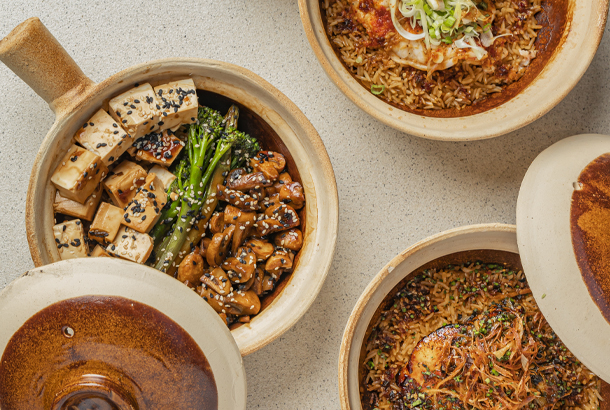
Sleepy from all that sun, I go for a relaxing massage at my hotel’s Talise Spa. I wish I had more time to hang out in the hammam, but I have a dinner reservation downtown at Jun’s Dubai, which Chinese-Canadian chef Kelvin Cheung opened in 2022 after a decade of cooking in India. His father owned Cantonese restaurants in Toronto and Chicago, and you’ll see their influence in dishes such as Wagyu beef and broccoli with, as Cheung describes it, “old-school, gloopy Chinese gravy.” Jun’s is all about what Cheung calls “third-culture cooking,” drawn from memories he collected over the years: a luxe seafood dish featuring poached lobster and otoro is based on humble buckets of Costco seafood salad; a Hokkaido scallop and corn plate references childhood visits to Ontario corn mazes; and beef cheek pastrami with kimchi and Chinese mustard conjures Montreal’s Jewish delis.
“I wanted to showcase my journey,” Cheung tells me, before explaining how the restaurant scene here has changed: “You used to see these places on the 64th floor with models and Burj views; now you’re seeing homegrown concepts doing well.” This place is already showing up on best-of lists, but there’s a level of warmth suffused throughout it. At one point, the chef walks by carrying a smiling infant. “This is something I picked up from my dad,” he says. “I just pick up random babies and walk around the restaurant.” It has the strange effect of making me (and everyone else) feel right at home.
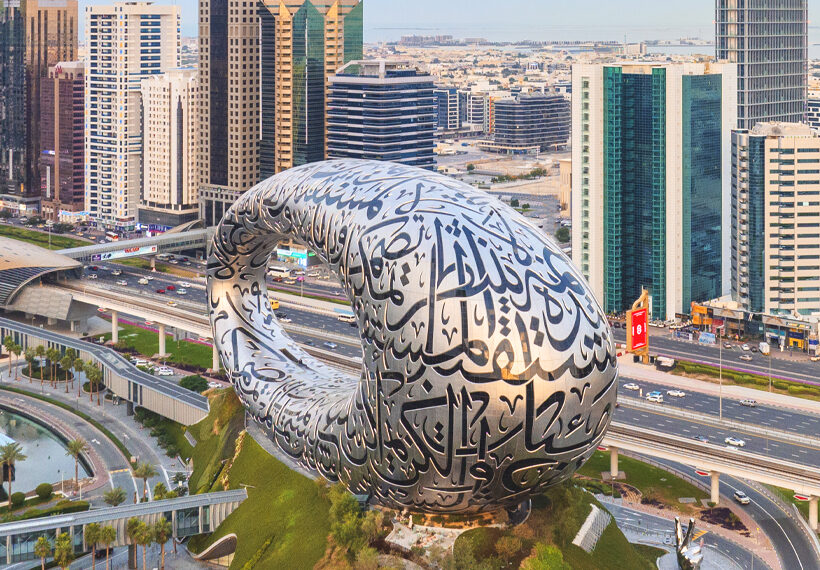
Day 2
The ultimate skyscraper, a look into the future, and a beloved curry
OK, I’ve avoided the near-gravitational pull of the Burj Khalifa long enough. The world’s tallest building (2,717 feet) dominates its surroundings, at twice the height of the Empire State Building. I take in a view of the tower, gleaming in the sun like a stack of shiny coins, from across an electric-blue chlorinated lagoon while I enjoy a flaky burek from the Balkan stand 21 Grams at the Time Out Market Dubai.
Breakfast done, I head for the Burj, passing the 10 million–liter, shark-filled tank of the adjacent Dubai Aquarium on the way. The elevators whisk me aloft to the 124th-floor observation deck; up here, I feel like a kid Colossus standing astride a city of toy blocks, the buildings below me designed so playfully it’s as if they’ve sprung from a child’s imagination: a hotel shaped like praying hands here, a nearly 500-foot-tall picture frame monument over there.
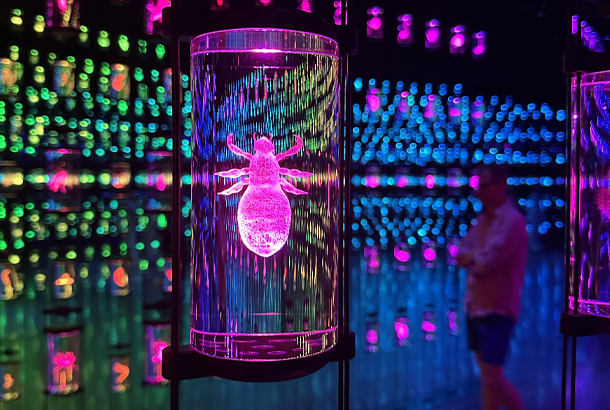
Back on solid ground, I head to the Museum of the Future, which looks like the eye of a needle and is covered in calligraphic quotes from the sheikh of Dubai. An elevator kitted out like a rocket blasts me skyward once more, to an exhibit that imagines a 2071 space station. As I wind my way through the collection. of real inventions and pie-in-the-sky ideas, I get a glimpse into the future of wellness (ultrasonic treatments), transportation (flying taxis), and health care (therapy robots). I’m most taken by the quieter areas, such as The Library, an installation of 2,400 crystal specimen jars, each etched with a species, from worms to whales; the room is meant to serve as a vault for all life forms, in the event of mass extinctions. It’s a beautiful, if sobering, reminder of all we might lose if the adaptations and practices imagined in institutions like this aren’t enacted.
For lunch, I head back to the past, at Ravi, a Pakistani hole-in-the-wall that’s been a cultural hub for Dubai’s vast South Asian population for 45 years. Located in the scruffier, pomp-free district of Satwa, the place overflows with tourists and taxi drivers, fashionistas and multigeneration families, who come for the fiery curries, buttery naan, and perfectly charred kebabs. Lately, they’ve also come for the emerald green Adidas merchandise, the fruits of an unlikely collaboration between the sneaker giant and the curry shop. (It’s part of a line that honors iconic global restaurants.)
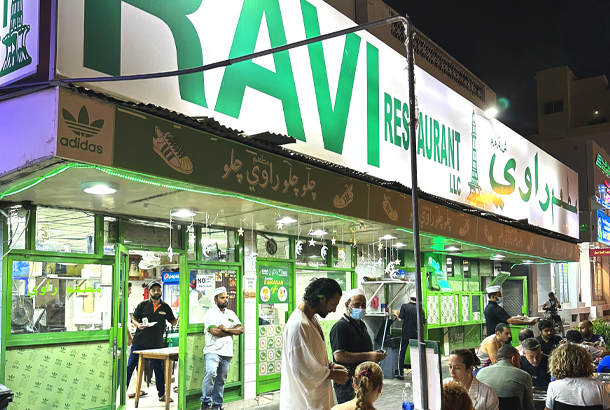
You might see those kicks on the cool kids on Alserkal Avenue, a warehouse arts district that opened 15 years ago in the industrial area of Al Quoz and is now home to avant-garde galleries, a performing arts center, and the female-led Cinema Akil, the Gulf region’s first arthouse theater. A representative for the district shows me around the blissfully pedestrian-friendly labyrinth of culture, which feels a bit like a Hollywood backlot. “The world has opened up to us,” she says, as we take in politically charged exhibits about the conflict in Kashmir and masculinity in Morocco. “Now we’re leading the conversation.”
I tell her that I’m surprised to see such challenging material in the galleries, because it goes against the way the West portrays the United Arab Emirates—a place where progress and growth, we’re taught, are tempered with rules about modesty and outdated gender structures. My image of Dubai, she tells me, is stuck in the past; not long ago, Alserkal even hosted an exhibit dedicated to female sexuality. “The media is showing you gentlemen in kanduras, but you never get to actually talk to them and see how cool they are,” she says. “The world is changing.”
For something a bit more hands-on—or nose-on—I’ve booked a fragrance-making workshop at Alserkal’s Oo La Lab, guided by the ever-patient Wadie Allati. He calls it “an easy hard process,” which involves sniffing aromas (rose, aldehyde, musk, peach…) and mixing them in the perfect ratio. Each scent, Allati says, comes with associations. He has me sniff “white flowers”—gardenia and jasmine—and asks me what image it conjures. I say an older woman, and he brightens up: “Exactly! People from around the world associate it with their grandmothers.”
The scent I concoct combines spicy, leathery, woody, and citrusy notes. The final step is naming it—and I’m stumped. Allati says it smells like driving through the green hills of Syria, where he’s from, with the windows down. Just then, another customer strolls in, and we recruit her to help. She’s Lebanese, and after breathing in deeply, she says that the scent reminds her of home, the smell of green after a rainstorm. I go with Levantine Hills.
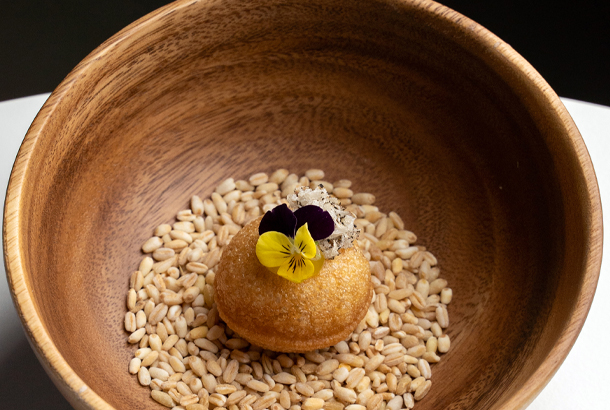
Dinner is at Moonrise, a 12-seat chef’s counter in a glass box atop a residential tower. The digs are elegant, but the vibe is decidedly unfussy, thanks to 20-something chef Solemann Haddad, who presides over the place in a backward ball cap and Nikes. “Wait until one of us tells you about the ingredients before you start eating,” he says, “because everything tastes better when you know the story.”
Michelin’s Dubai Young Chef of the Year for 2022, Haddad earned his first star this spring, and his menu is filled with references to the food he ate growing up in Dubai, from a fattoush-like tomato ceviche to a Jordanian A5 Wagyu kebab that comes with a business card from his favorite kebab shop, Khoori. The dishes represent his personal biography more than the culture at large: “I cook my childhood,” he says, as he serves us grilled cheese (“the first thing I ever cooked”) made with 36-month-aged Parmesan and sliced truffle. The culture of the UAE is still growing and changing rapidly, so culinary traditions are far from set in stone. “Growing up in Dubai,” Haddad says, “the rules are so loose.”
Still, there’s a whiff of history to the close of the meal, as Haddad dims the lights and burns some wood on an open grill to mimic “going to the desert and making a fire and sitting under the starry night.” Even in the heart of this densely packed city, his cooking transports me; I may not have grown up in the emirate in the 1990s, but Haddad’s wistful culinary sentimentality is contagious.
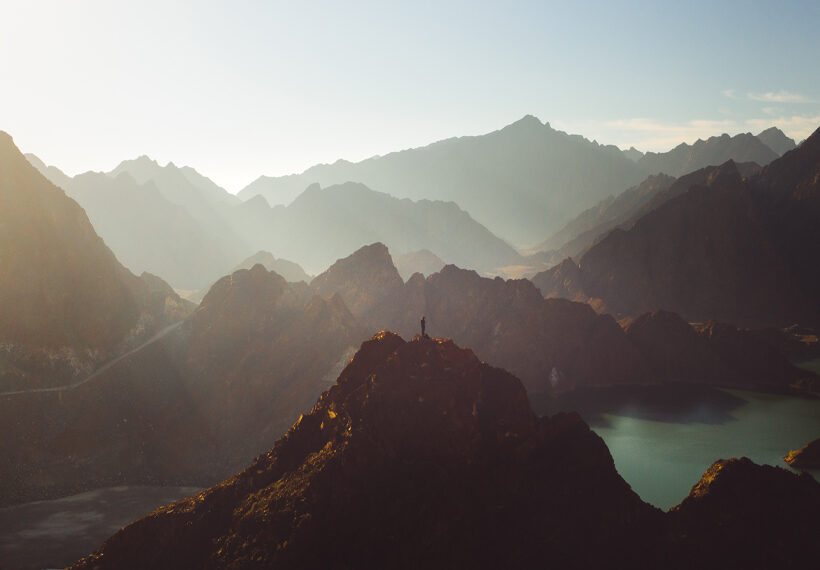
Day 3
A boat ride, a beekeeping lesson, and a barbecue beneath the stars
You can’t come to the Arabian Peninsula without exploring the desert, and today I’m venturing out to a mountain settlement called Hatta, about a 90-minute drive east of the city of Dubai. The village is perhaps the closest I’ll come to seeing what the UAE was like in the pre-oil days, but before I set out I’m having the most traditional breakfast in the city, at the Arabian Tea House. On my table in the tree-shaded courtyard is a kitschy salt-and-pepper duo depicting a man in a kandura and a woman wearing a beak-like metallic face mask called a Gulf burqa (not to be confused with the head covering). My overflowing tray of snackables and rippables and dippables includes khameer (flatbread), chebab (saffron-cardamom pancakes), balaleet (sweet vermicelli), watermelon jam, date molasses, and more.
I wander the streets of the adjacent Al Fahidi Historical Neighborhood, a warren of tightly interlocked alleys—some now decked out with street art—and buildings topped with wind towers, an age-old architectural feature that collects cool breezes and funnels them into the homes below. When I reach Dubai Creek, I pay a dirham to hop aboard an abra, or water taxi. On the opposite shore, I find myself in the land of souks, themed markets dedicated to everything from spices and perfumes to textiles and gold. The traditional wedding jewelry pieces I gawk at here are, conservatively, the size of hubcaps.
Hatta is calling, though, and I meet my driver to begin the trip out to the 50-square-mile exclave of the emirate of Dubai. The village is perched high in the arid Hajar Mountains and bordered by two other emirates and Oman—in fact, the land was part of Oman until about the 1850s, and it still remains something quite separate, geographically and spiritually, from the big city.
My first destination is Hatta Resorts, which comprises Hatta Dome Park, a glamping retreat made up of geodesic domes, as well as hiking and mountain biking trails, zip lines, ropes courses, and more. At check-in, I’m asked if I’d prefer tonight’s dinner beraw or cooked. I’m caught off guard by the question and say, “Uh, raw,” before dropping my bags in my dome.
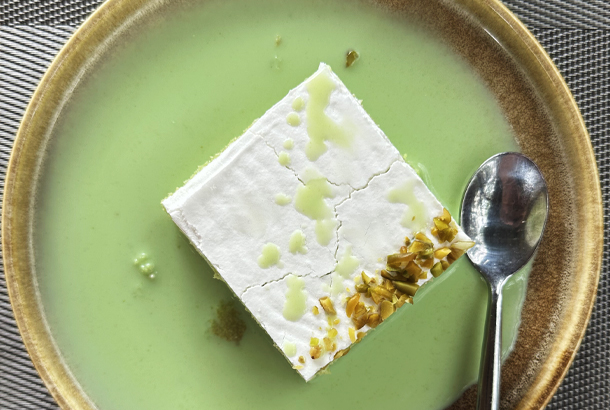
For lunch, I head to Al Hajarain Restaurant at the Hatta Heritage Village. Sitting on the patio, I order a chicken makboos, a homey Emirati rice dish that’s sort of like biryani and is cooked with dried lemon, baharat (an Arab spice blend), and onion. Throughout the meal, I’m given a show by a resident Indian roller, a bird known for its acrobatic exploits. The roller’s wings flash in such shockingly vibrant shades of blue and teal that the vacationing family next to me shriek-giggles with glee.
From here, I make my way toward Hatta Dam, a watersports hub with a reservoir full of water so outlandishly turquoise it looks like it was copy-and-pasted in from the Canadian Rockies. As I zip around on a nimble electric boat, I watch a pair of mountain goats navigate the waterside cliffs with sure-footed confidence.
Now for something sweet: a tour of the Hatta Honeybee Garden and Discovery Center. I don a protective suit and get a lesson in beekeeping, learning about the various indigenous trees—including sidr, ghaf, and acacia—that give the honey from these parts its unique flavor. I buy so many jars to take home that I’m relieved I packed an extra duffel bag.
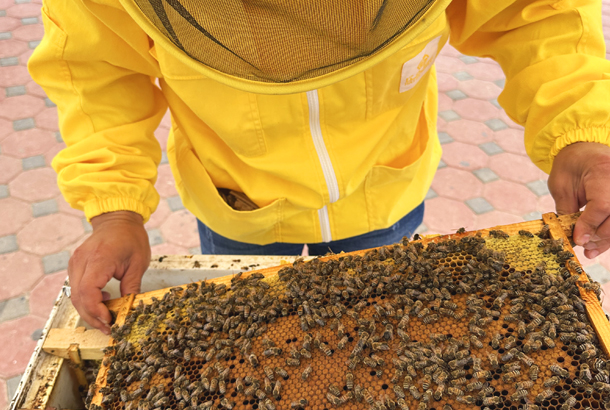
It’s dark by the time I return to Hatta Dome Park, where I find out what all that talk of raw dinner meant. A man pulls up to my dome in a buggy and drops off firewood and a box of uncooked chicken, lamb, and spiced kebabs, with all the fixings: salad, tabbouleh, hummus, baba ghanoush, and piles of pita. It’s enough food for a small army, but I—an unrepentant city dweller—have no idea how to get a barbecue started with just wood and matches. I try to ask for help, but the attendant doesn’t speak English. After some clumsy typing into a translator app, I learn that he speaks Telugu and would be happy to get the blaze going for me.
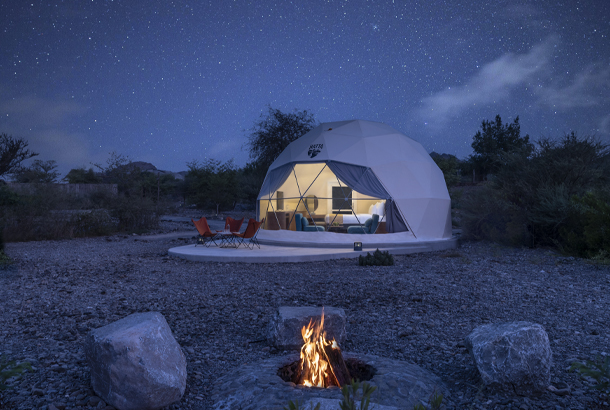
As I stand there grilling beneath a canopy of blazingly bright stars, kept company by a stray cat who loudly begs for scraps, I couldn’t feel further away from the glamour of the big city. I have to imagine that 90 percent of visitors to Dubai never experience this kind of quiet. Then, the serenity is pierced by the sound of the adhan, the Muslim call to prayer. I can’t tell if it’s coming from near here or perhaps from one of the other emirates or even from Oman, a few miles away, but it thrusts me into the past, before borders divided this land, before Dubai started its no-holds-barred drive into the future.

